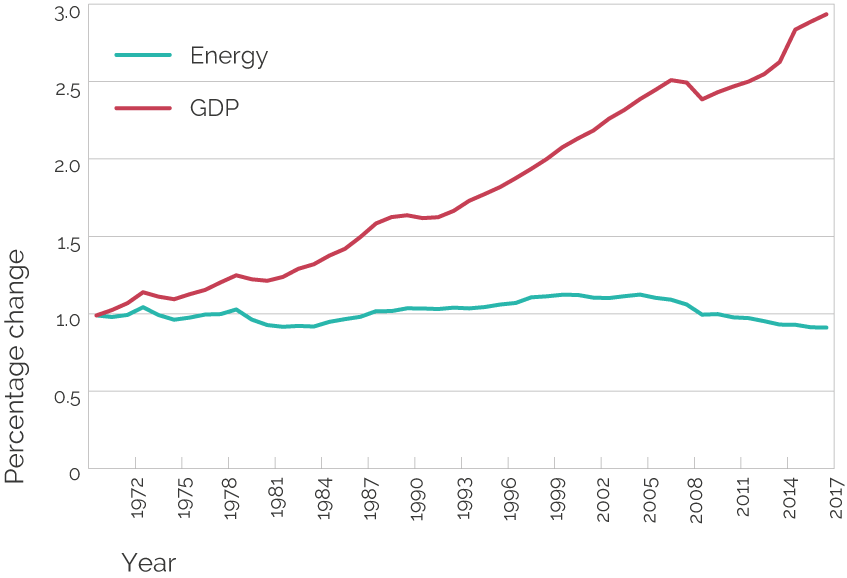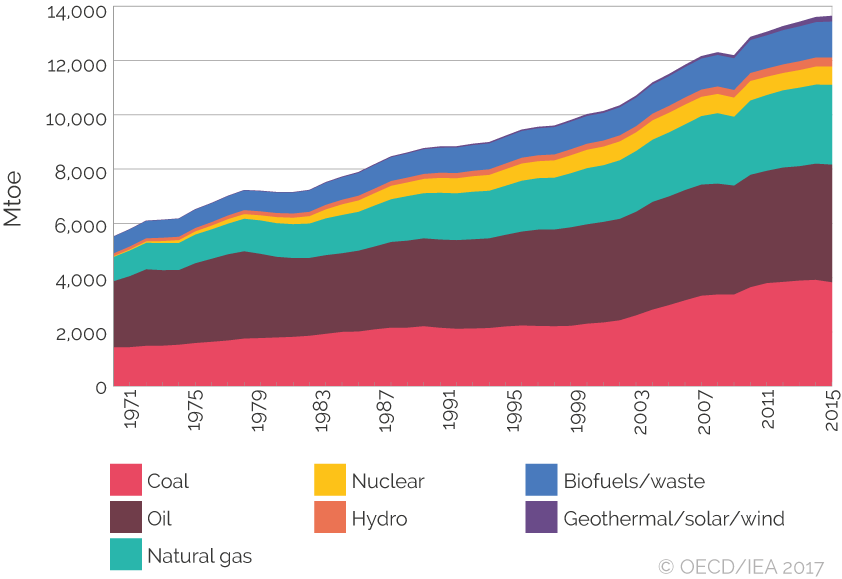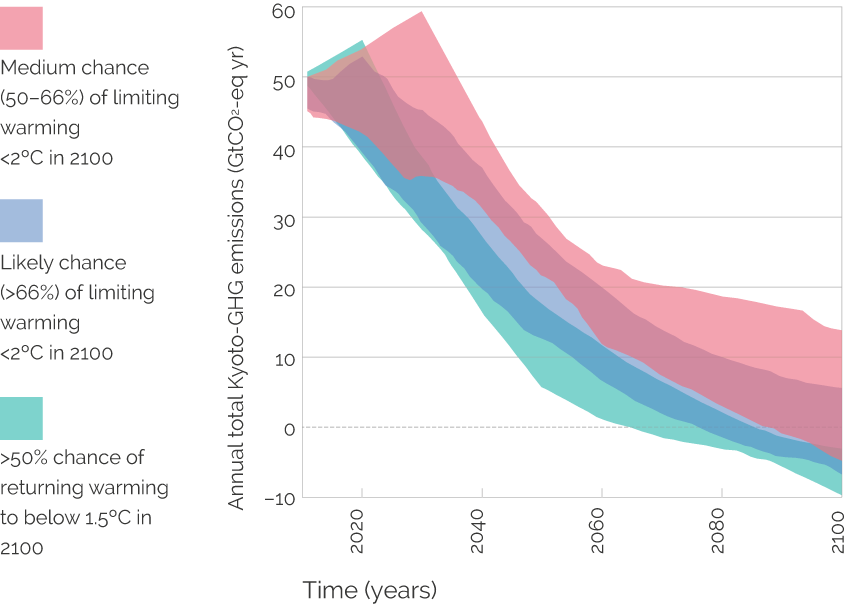Nick Eyre
Summary
Energy demand in some European countries has been falling for some time, yet the scope for further reductions in demand is considerable, argues Professor Nick Eyre, FEI. Just as well, as considerably larger falls are required.
Energy demand is often a secondary consideration in discussions about the low carbon energy transition. If it is mentioned at all, many commentators assume that all that the demand side can offer is a continuation of historical trends in efficiency improvement. This is a mistake. The agenda for energy demand change is much bigger than marginal efficiency improvement, and is critical to the low carbon transition.
A number of challenges need to be addressed:
- demand reduction – using the potential for energy efficiency and conservation to reduce demand more quickly than we have achieved historically;
- demand response – shifting demand in time to match the availability of variable renewables; and
- switching fuel – to electricity and other low carbon fuels.

In the last decade, energy demand in some European countries, including the UK, has fallen. Figure 1 shows the UK trends since 1970 in energy use and gross domestic product (GDP). GDP has almost tripled since 1970. In the same period energy demand has fallen by 8%, so the energy intensity of the economy has fallen by a factor of three. This has been critical to making energy affordable, ensuring adequate capacity and reducing emissions.
However, in the rest of the world, the situation is different, as Figure 2 shows. In developing countries, in particular, energy use is rising, driven by rising demand for energy services. Improved energy efficiency reduces the rate of energy demand growth, but does not reverse it. Since the industrial revolution, energy supply has been dominated by fossil fuels. Demand growth therefore drives increased use of fossil fuels and carbon emissions.
Future trends need to be very different. As Figure 3 illustrates, the commitments made collectively by the governments of the world in the 2015 Paris Agreement imply a profound change from historical trends in carbon dioxide emissions, and therefore in the use of fossil fuels.
Globally, continued economic and population growth seem highly probable. In these circumstances, there are only two approaches to reducing carbon emissions. The first is to reduce the carbon intensity of energy, by changing to carbon neutral energy sources. The second is to reduce the energy intensity of the economy, through energy efficiency and conservation. To achieve the very rapid reductions required to meet the Paris Agreement both will be needed.
Limiting rises in global temperature to 2°C will be very challenging; achieving it without increased rates of efficiency improvement is a near impossibility.
Demand reduction
According to the International Energy Agency, energy efficiency will continue to be the largest single contributor to the emissions reduction we need to stabilise the climate. It provides most of the cheap options for greenhouse gas abatement, as lifetime energy cost savings usually outweigh the additional capital expenditure.
Of course, thermodynamics pose some limits to efficiency improvement, but we are currently far away from what can be achieved. A study by the US National Academy of Sciences found that the potential for cost-effective energy efficiency has not fallen over several decades, because innovation provides new options as fast as existing energy efficient technology is deployed.
The main constraints on improving efficiency relate to the interaction of the technology with people. In energy supply, most investment and operational decisions are made by people employed specifically to make those decisions. The same applies to energy efficiency in some large organisations, but in households and small businesses, decisions about energy investment are made by ‘non-experts’. In most cases, the equipment supply chain has no interest in ensuring that optimal (or even good) decisions are made by their customers. Decision making is far from optimal.
There is no single easy answer to this problem. We cannot realistically expect that most people will become energy experts. But that does not mean nothing can be done. Products standards can require higher efficiency; supply chains can be better trained; management systems can focus on energy performance; consumers can be better informed and advised. We have decades of experience in how to do these effectively.
Most demand reduction is delivered through energy efficiency, but the older concept of energy conservation, reducing the demand for energy services, is also relevant. This is often thought of negatively, for example as ‘shivering in the dark’. But there are plenty of examples of people reducing their demand for energy services without being worse off. Cycling and walking for short journeys, eating local food and reusing waste all save energy, with positive impacts on health and personal budgets.
Demand response
In the energy transition, the amount of energy we use will continue to be important, but the timing of demand will increasingly matter. This is especially true for electricity, where supply and demand need to be balanced in close to real time. As the use of variable energy sources increases, there will be a premium on flexibility. Flexible generation, interconnection and electricity storage will play a role, but so will demand response (flexibility of demand in time) by business and household electricity users, especially where this can deliver flexibility most cheaply.

Demand response can be achieved in two ways. The first is by re-timing energy services, which are not time critical, such as clothes washing. The second is by users storing energy for later use, for example as thermal energy in a hot water tank, cooling appliance or building fabric. Collectively, these changes have the potential to shift significant demand over periods of minutes or hours. And the economic benefits are potentially large – £800mn annually in the UK according to the National Infrastructure Commission.

However, just as with energy efficiency improvement, the technical potential and economics are not the whole story. Demand response through interruptible contracts has been familiar to large energy users for decades, but it is a new idea for most energy users. It requires the use of smart meters and, if the incentive is to be financial, time of use pricing. In many cases, it will require the energy user to delegate control of their equipment to another actor, such as an energy supplier.
These sorts of changes in business models and tariffs may seem perfectly reasonable and desirable to industry experts. However, if they are to be socially acceptable, they need a level of citizen engagement that large energy companies are currently not well-positioned to deliver.
Switching fuel
Whilst much of energy policy focuses on electricity supply, we should not forget that 80% of final energy use is not electricity. Direct use of fossil fuels is dominant in transport, heating and industrial processes. Analyses of decarbonisation, by the Committee on Climate Change and others, indicate that the early priority is to decarbonise electricity. This makes decarbonising transport, industrial processes and heating easier, to the extent that they can then be done by switching to electricity.
This is beginning to happen in transport, initially with hybrids, but increasingly with fully electric vehicles. With falling battery costs, there are good grounds for optimism that light vehicles can largely be decarbonised in this way.
For other end uses, total electrification is less likely. Reliance on batteries for heavy goods vehicles is more difficult; for long distance modes such as shipping and aviation it is implausible. For some industrial process, moving away from direct fuel combustion is difficult, because the fuels play a role as a chemical feedstock and/or reductant.
Complete electrification of building heating also seems unlikely. In the UK, heating demand is dominated by space heating, which is highly seasonal and very weather dependent. Even with efficient heat pumps, complete electrification of existing UK residential heating would increase peak electricity demand by around 40 GW. Much of this new generation capacity would be used only in cold weather, and therefore with a very low load factor. It is difficult to see how this could ever be economic.
In all these cases, zero carbon fuels other than electricity seem likely to be needed. In the UK, our options are likely to be limited. Biofuels could play an increased role, but their production in the UK is constrained by competition for land use, and relying on imported bioenergy seems unwise in a world where other countries will be facing the same decarbonisation challenges.
This challenge of limited options is driving interest in hydrogen as a fuel for heating, transport and industrial processes. It is possible to convert the existing gas distribution network to hydrogen. In principle, hydrogen can be manufactured at scale, either from natural gas by steam methane reforming (SMR) or from electricity by electrolysis.
SMR is a well-established process for industrial hydrogen but, to be low carbon, would require using carbon capture and storage. Electrolysis is not cost effective at current electricity prices, although that could change if the growth of variable generation leads to long periods with low electricity wholesale prices.
The route to full decarbonisation of the whole economy is therefore not yet clear. The current focus is on understanding the technology and economics of fuel switching. But again, social issues will prove critical. Changing the fuels used by vehicles and homes cannot be assumed to be acceptable just because it is possible. Perceptions of safety, performance and cost will all be critical, and will depend on trust in supply chains and public authorities.
Conclusions
In recent decades, improvements in energy efficiency have been critical to the cost effectiveness and security in the UK energy system, and in beginning its decarbonisation. To achieve complete decarbonisation, demand side changes will become even more important. Demand will need to be reduced faster; it will need to be made flexible; and, in many cases, the fuels used will need to change. All of these pose substantial technical challenges.
At least as importantly, citizens need to be engaged, consumers and employees informed, and supply chains trained, all on a scale beyond anything experienced in our lifetimes.
In the Centre for Research into Energy Demand Solutions (CREDS), we will be undertaking research on these topics. But enough is already known for practitioners and policymakers to take action. The agenda for energy professionals has never been more challenging or more interesting.
Publication details
Eyre, N. 2019. Energy demand in the energy transitionOpens in a new tab. Energy World, 479. 14-15.
Banner photo credit: Alireza Attari on Unsplash
